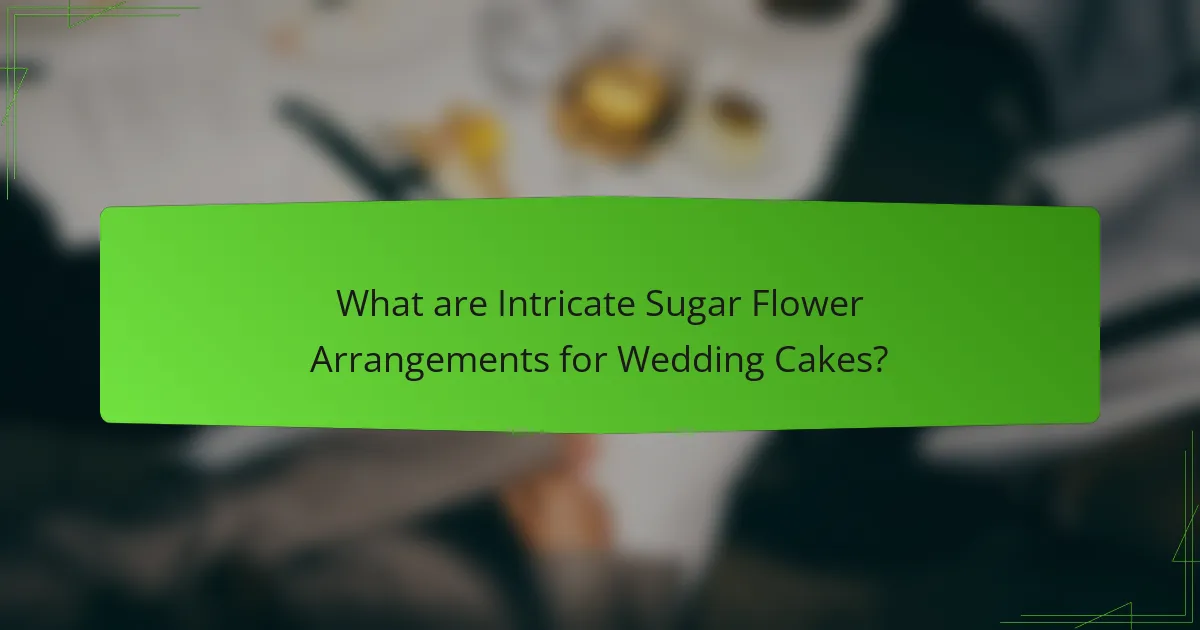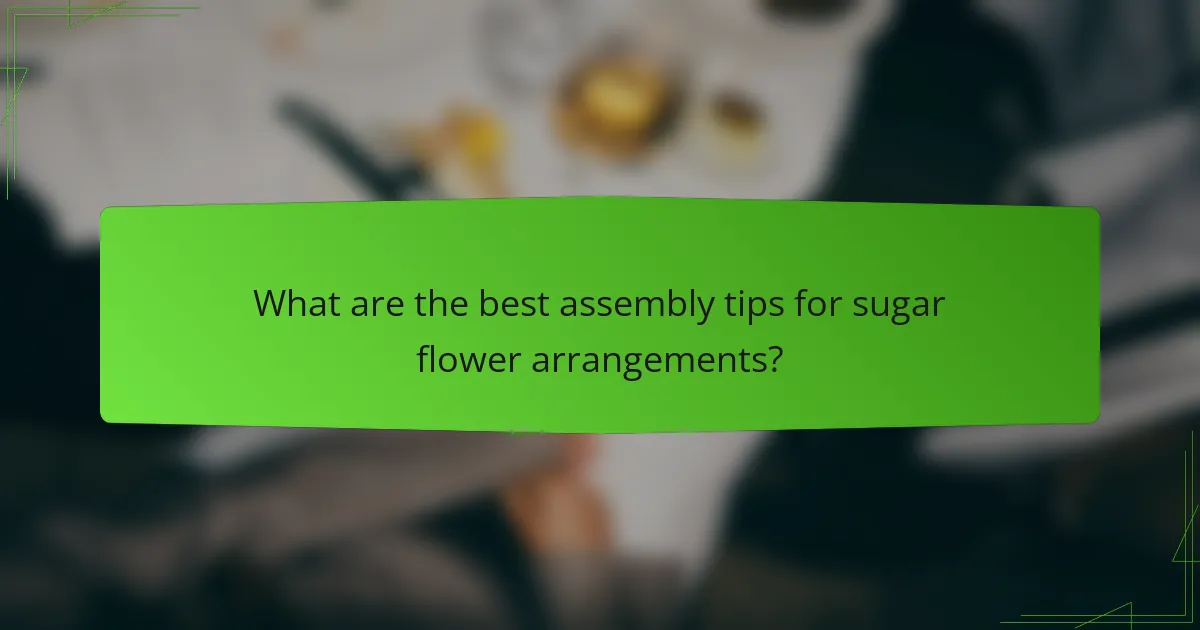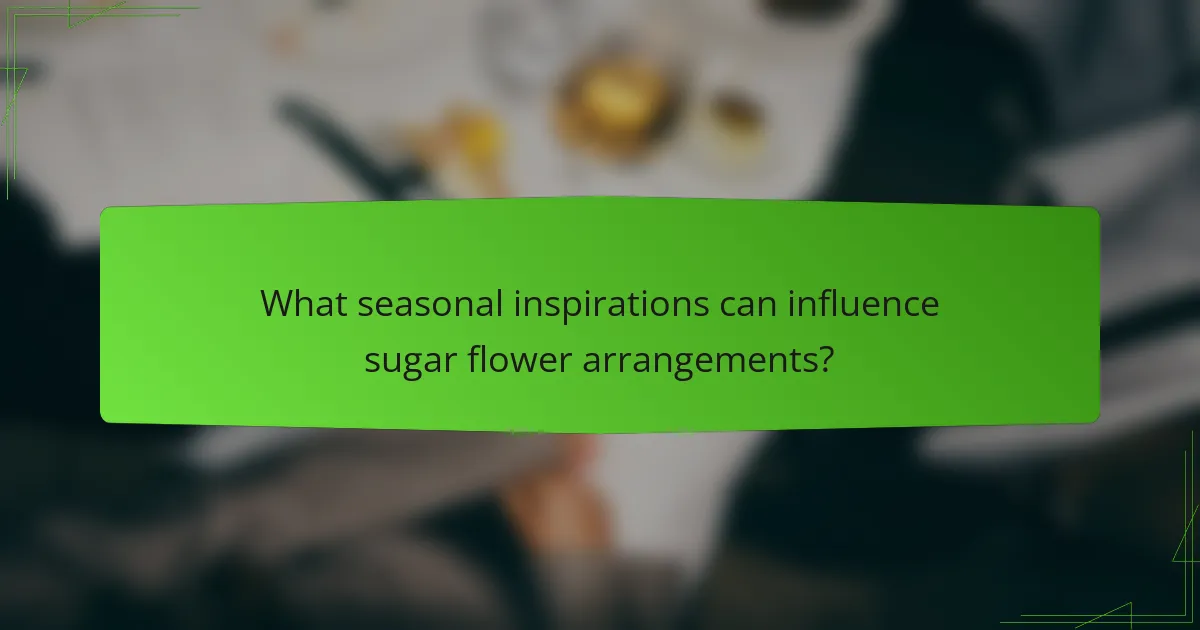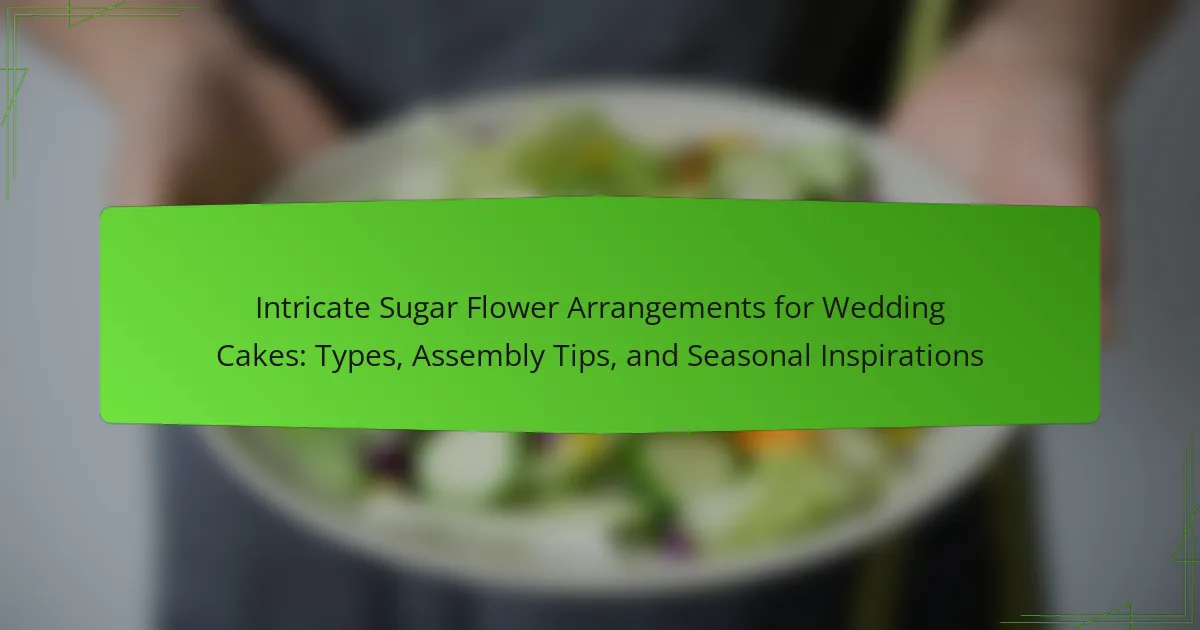
What are Intricate Sugar Flower Arrangements for Wedding Cakes?
Intricate sugar flower arrangements for wedding cakes are detailed, handcrafted decorations made from sugar paste or fondant. These arrangements mimic real flowers in appearance and texture. They are often used to enhance the aesthetic appeal of wedding cakes. Skilled cake decorators create these flowers using various techniques, including molding and painting. The flowers can be customized to match the wedding theme or color palette. Common types include roses, peonies, and orchids. These arrangements not only add beauty but also showcase the artistry of cake design. Their popularity in weddings stems from their elegance and the ability to last long after the event.
How are sugar flower arrangements created for wedding cakes?
Sugar flower arrangements for wedding cakes are created through a meticulous process involving several steps. First, sugar paste or gum paste is prepared and colored to match the desired flower types. Then, the paste is rolled out and shaped into petals and leaves using specific tools. Each piece is often wired for stability and to allow for realistic positioning on the cake.
Once shaped, the flowers are dried to hold their form. Edible dust or petal powder is applied to add depth and realism to the flowers. Finally, the arrangements are assembled on the cake, often using a combination of fresh and sugar flowers for a striking effect. This method allows for intricate designs that can be customized for any wedding theme.
What materials are commonly used in sugar flower arrangements?
Common materials used in sugar flower arrangements include gum paste, fondant, and edible dusts. Gum paste is a pliable sugar dough that hardens, making it ideal for intricate flowers. Fondant is another sugar-based medium that provides a smooth finish for decorations. Edible dusts add color and dimension to the flowers. Additionally, floral wires and tape are used for structure and assembly. These materials allow for creativity and detail in sugar flower designs.
What techniques are essential for crafting sugar flowers?
Essential techniques for crafting sugar flowers include gum paste preparation, floral wire insertion, and petal shaping. Gum paste is a pliable medium that allows for detailed flower designs. Properly inserting floral wire provides support for the flower structure. Petal shaping involves using tools to create realistic textures and forms. Additionally, dusting with edible colors enhances the visual appeal. Finally, assembly techniques ensure the flowers are securely attached to the cake. Mastering these techniques allows for the creation of lifelike sugar flowers.
What types of sugar flower arrangements are popular for weddings?
Popular types of sugar flower arrangements for weddings include roses, peonies, and orchids. Roses are favored for their classic beauty and versatility. Peonies are loved for their lush and romantic appearance. Orchids add an exotic touch and elegance to arrangements. Sunflowers are chosen for rustic-themed weddings due to their cheerful look. Hydrangeas are appreciated for their fullness and variety of colors. These flowers can be crafted in various colors and sizes to match wedding themes. Each type of sugar flower can be customized to suit the couple’s preferences.
What are the most common flower types used in sugar arrangements?
The most common flower types used in sugar arrangements include roses, peonies, and orchids. Roses are favored for their classic beauty and versatility. Peonies are popular for their lush, full appearance. Orchids add an exotic touch and come in various colors. Other frequently used flowers are daisies, hydrangeas, and lilies. These flowers are chosen for their aesthetic appeal and ability to complement wedding cake designs. Their popularity is supported by their frequent appearance in floral arrangements and cake decorations.
How do color choices impact sugar flower arrangements?
Color choices significantly impact sugar flower arrangements by influencing aesthetics and emotional responses. Different colors evoke specific feelings and set the overall tone for the arrangement. For instance, soft pastels create a romantic and delicate ambiance, while vibrant colors can convey joy and celebration.
Additionally, color combinations can enhance visual harmony or contrast within the arrangement. Complementary colors draw attention to specific flowers, while analogous colors create a cohesive look. Research indicates that color theory plays a crucial role in design, affecting viewer perception and emotional engagement.
Thus, selecting the right colors is essential for achieving the desired effect in sugar flower arrangements.
Why are sugar flower arrangements significant in wedding cake design?
Sugar flower arrangements are significant in wedding cake design because they enhance the aesthetic appeal of the cake. These arrangements add a touch of elegance and personalization to the overall presentation. Sugar flowers can be crafted to match the wedding theme and color palette. This customization allows couples to incorporate their unique style into their cake. Additionally, sugar flowers are durable and can last for years, serving as a keepsake. Their intricate designs showcase the skill of the cake artist. According to a survey by The Knot, 40% of couples prioritize cake design in their wedding planning. This highlights the importance of visually appealing elements like sugar flowers in making a lasting impression.
How do sugar flowers enhance the aesthetic of wedding cakes?
Sugar flowers enhance the aesthetic of wedding cakes by adding intricate detail and elegance. They provide a visually stunning focal point that elevates the overall design. Sugar flowers can be customized in color and size to match the wedding theme. Their realistic appearance mimics natural blooms, creating a lifelike effect. Additionally, they can be arranged in various styles, from cascading to clustered designs. The use of sugar flowers allows for creativity without the limitations of seasonal availability. Their durability ensures that the cake remains beautiful throughout the event. Overall, sugar flowers contribute significantly to the cake’s artistic presentation.
What emotional significance do sugar flowers hold for couples?
Sugar flowers symbolize love and commitment for couples. They often represent the beauty and fragility of relationships. Couples choose sugar flowers for wedding cakes to convey personal emotions. The intricate designs reflect the care and effort put into the relationship. Sugar flowers can also represent significant moments or memories shared between partners. For many, these edible decorations enhance the overall aesthetic of the wedding cake. This adds to the emotional experience of the celebration. The choice of specific flowers can hold personal meanings, further deepening their significance.

What are the best assembly tips for sugar flower arrangements?
The best assembly tips for sugar flower arrangements include using a sturdy base to support the flowers. Ensure that the flowers are completely dry before assembly to maintain their shape. Use edible glue for attaching petals and leaves securely. Arrange larger flowers first, followed by smaller ones for visual balance. Consider the color scheme and size of the arrangement to create harmony. Utilize floral wires for added stability and to create height. Lastly, store the completed arrangement in a cool, dry place to prevent any damage. These practices enhance the overall aesthetic and durability of the sugar flower arrangement.
How should sugar flowers be arranged on wedding cakes?
Sugar flowers should be arranged on wedding cakes in a balanced and aesthetically pleasing manner. Begin by placing larger flowers at the base or focal points. This creates a strong foundation for the arrangement. Next, distribute medium-sized flowers evenly around the cake. Ensure they complement the larger flowers without overshadowing them. Finally, add smaller flowers and filler elements to fill gaps and enhance visual interest.
Consider the color palette and theme of the wedding when arranging. Use a mix of colors that harmonize with the cake’s design. The arrangement should guide the eye upwards, creating a sense of flow. Additionally, ensure that the sugar flowers are securely attached to prevent them from shifting.
Arranging sugar flowers thoughtfully can elevate the overall look of the cake. Proper placement enhances the cake’s elegance and complements the wedding theme.
What are the best practices for spacing and placement of flowers?
Best practices for spacing and placement of flowers include ensuring adequate distance between each flower. This allows for visibility and prevents overcrowding. A general rule is to space flowers about one to two inches apart. Consider the size and type of flowers when determining spacing. Larger flowers require more space than smaller ones. Additionally, place flowers in clusters for visual interest. Varying the height and angle of flowers adds depth to the arrangement. Use a focal flower to draw attention and arrange smaller flowers around it. This technique enhances the overall aesthetic.
How can stability be ensured in sugar flower arrangements?
Stability in sugar flower arrangements can be ensured by using a sturdy base and proper support structures. A firm foundation, such as a cake or a foam base, provides essential stability. Additionally, using floral wires and tape can reinforce the flowers, preventing them from drooping or falling. The arrangement should be balanced, distributing weight evenly to avoid tipping. Proper drying techniques also contribute to stability, as fully dried sugar flowers are less likely to bend or break. These methods are standard in professional cake decorating, ensuring that arrangements maintain their shape and integrity throughout the event.
What tools and materials are essential for assembling sugar flowers?
Essential tools and materials for assembling sugar flowers include gum paste, floral wire, and floral tape. Gum paste is a primary material used for creating the petals and leaves. Floral wire provides support and structure to the sugar flowers. Floral tape is used to bind the wire and create realistic stems. Additionally, a rolling pin is necessary for flattening the gum paste. A flower former helps shape the petals during drying. A set of modeling tools is essential for adding details and textures. A palette knife is useful for cutting and shaping the gum paste. Lastly, edible dust or petal dust enhances the color and realism of the flowers.
Which tools make the assembly process easier and more efficient?
Essential tools for the assembly process of intricate sugar flower arrangements include a flower nail, edible glue, and a rolling pin. A flower nail allows for easy positioning and shaping of petals. Edible glue secures flower components together, ensuring stability. A rolling pin helps achieve uniform thickness in sugar paste. Additionally, a crafting knife is crucial for precise cutting of shapes. A pair of tweezers aids in handling delicate pieces. Finally, a drying rack is essential for allowing flowers to set without distortion. These tools streamline the assembly, enhancing efficiency and precision in creating beautiful arrangements.
What types of adhesives are recommended for sugar flower arrangements?
Edible glue and tylose powder mixed with water are recommended adhesives for sugar flower arrangements. Edible glue is specifically designed for use with sugar and is safe for consumption. Tylose powder creates a strong bond when mixed with water, making it ideal for adhering sugar flowers to each other or to cake surfaces. These adhesives are preferred because they dry clear and provide a secure hold. Using these types ensures that the final arrangement is both beautiful and safe for eating.

What seasonal inspirations can influence sugar flower arrangements?
Seasonal inspirations that can influence sugar flower arrangements include spring blooms, summer florals, autumn leaves, and winter greenery. Spring offers vibrant flowers like tulips and daffodils, which can be mimicked in sugar form. Summer brings sunflowers and peonies, known for their bold colors and textures. Autumn introduces warm hues with sugar replicas of chrysanthemums and maple leaves. Winter inspirations often feature evergreen branches and poinsettias, ideal for festive arrangements. Each season provides distinct color palettes and floral varieties, enhancing the visual appeal of sugar flower designs.
How do seasonal flowers impact wedding cake designs?
Seasonal flowers significantly influence wedding cake designs by dictating color schemes and themes. They provide natural beauty and freshness that align with the wedding’s overall aesthetic. For instance, spring flowers like peonies and tulips can create a vibrant and romantic look. In contrast, autumn blooms such as dahlias and chrysanthemums offer rich, warm tones. Seasonal availability also affects the cost and quality of the flowers used. Using local, in-season flowers often results in better freshness and sustainability. Additionally, incorporating these flowers can enhance the cake’s visual appeal and complement the wedding decor. Overall, seasonal flowers play a crucial role in creating cohesive and stunning wedding cake designs.
What are the best flower choices for spring weddings?
The best flower choices for spring weddings include peonies, tulips, and daffodils. Peonies are favored for their lush blooms and sweet fragrance. Tulips offer a variety of colors and a sleek shape, making them versatile. Daffodils symbolize new beginnings and add a cheerful touch. Other popular choices are hyacinths and lilacs, known for their vibrant colors and pleasant scents. These flowers are typically in season during spring, ensuring freshness and availability for wedding arrangements.
What seasonal color palettes are trending for wedding cakes?
Trending seasonal color palettes for wedding cakes include soft pastels for spring, vibrant jewel tones for summer, warm earth tones for autumn, and icy blues and whites for winter. Spring palettes often feature blush pink, lavender, and mint green. Summer cakes embrace bold colors like royal blue, fuchsia, and sunny yellow. Autumn designs incorporate deep burgundy, burnt orange, and golden yellow. Winter cakes often showcase silver, navy, and white, reflecting a frosty aesthetic. These color choices align with seasonal themes and enhance the overall wedding decor.
How can couples personalize their sugar flower arrangements?
Couples can personalize their sugar flower arrangements by selecting specific flower types that hold personal significance. For example, they may choose flowers that represent their relationship milestones, such as the first flower they exchanged. Additionally, couples can customize color schemes to match their wedding theme or personal preferences. Incorporating initials or meaningful symbols into the arrangement adds a unique touch. They can also vary the size and scale of the flowers to create a distinct look. Using different textures or finishes, like metallic or matte, can enhance the visual appeal. Personalization can be further achieved by adding edible glitter or dust for a special effect. Each of these choices reflects the couple’s personality and story, making the arrangement truly one-of-a-kind.
What unique themes can be incorporated into sugar flower designs?
Unique themes that can be incorporated into sugar flower designs include seasonal motifs, color palettes, and cultural symbols. Seasonal motifs might feature spring blossoms, autumn leaves, or winter florals. Color palettes can range from pastel shades for a soft look to bold hues for a vibrant appearance. Cultural symbols may include traditional flowers from specific regions or floral arrangements that represent significant meanings. These themes enhance the visual appeal of sugar flowers and create a personalized touch for wedding cakes. The incorporation of these themes allows for creativity and individuality in cake design.
How can personal stories be reflected in sugar flower choices?
Personal stories can be reflected in sugar flower choices by selecting flowers that hold personal significance. For example, a bride may choose peonies because they were her mother’s favorite flower. This choice creates a connection to family history and memories. Additionally, flowers can symbolize important life events, such as roses for a first date or daisies for a childhood garden. Each flower type can evoke specific emotions or narratives tied to personal experiences. This personalization adds depth and meaning to the sugar flower arrangements. Ultimately, these choices transform the cake into a storytelling medium, celebrating love and cherished moments.
What are some practical tips for creating sugar flower arrangements?
To create sugar flower arrangements, start by selecting high-quality gum paste or fondant. Use a rolling pin to flatten the paste to the desired thickness. Employ flower cutters to shape the petals and leaves accurately. Use floral wires to support the petals and create structure. Dust the petals with edible colors for realism. Allow the flowers to dry completely to maintain their shape. Assemble the flowers on a cake using edible glue or royal icing. Arrange the flowers in a visually appealing manner, considering balance and color harmony.
Intricate sugar flower arrangements for wedding cakes are detailed decorations made from sugar paste or fondant that mimic real flowers. This article covers the creation process, popular flower types such as roses and peonies, essential techniques, and materials used. It also explores the significance of color choices, seasonal inspirations, and personalization options for couples. Additionally, practical assembly tips and best practices for stability and placement are provided to enhance the aesthetic appeal of wedding cakes. Overall, the article serves as a comprehensive guide to understanding and crafting beautiful sugar flower arrangements for weddings.
